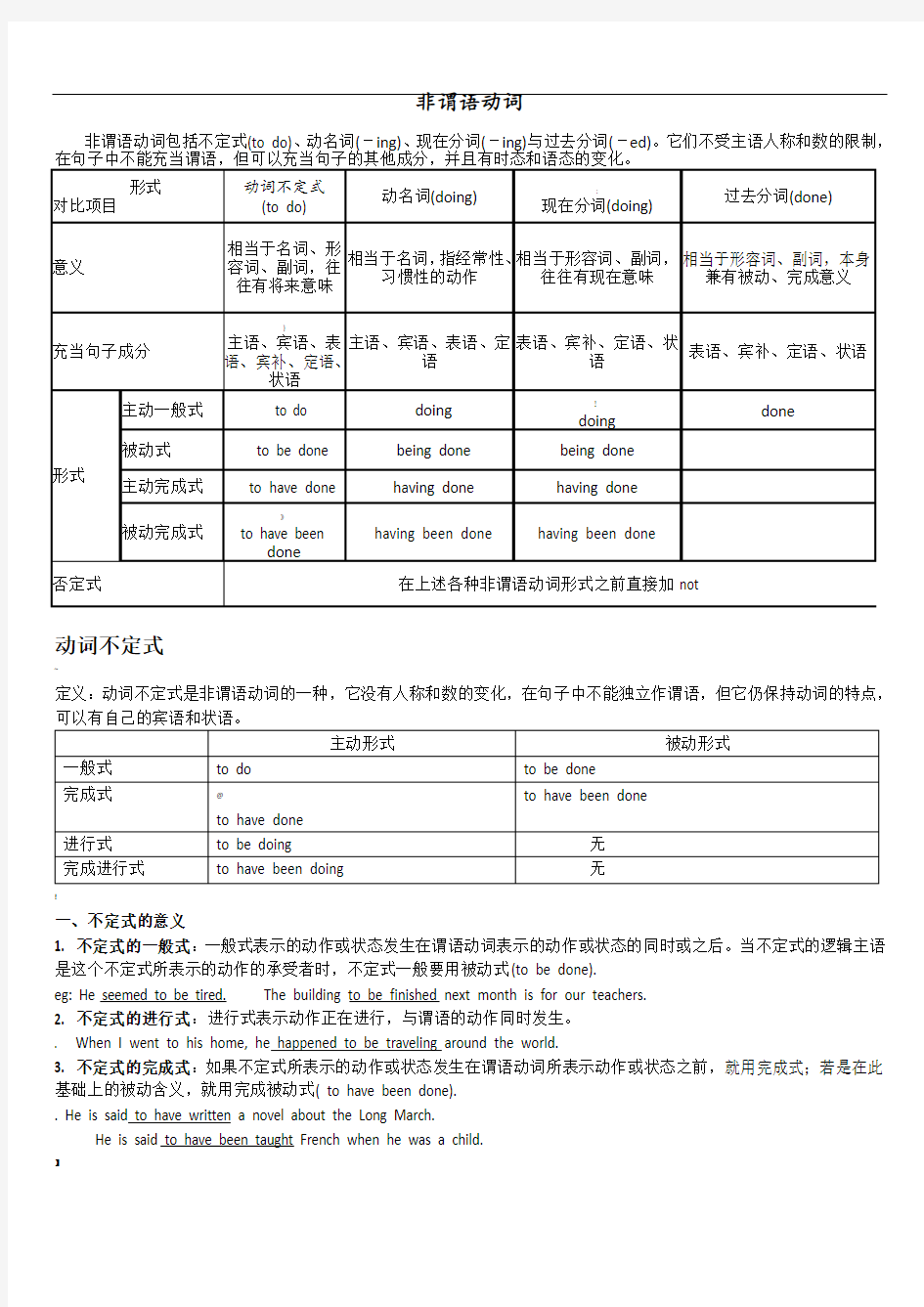高中的英语非谓语动词讲解-(整理)

- 1、下载文档前请自行甄别文档内容的完整性,平台不提供额外的编辑、内容补充、找答案等附加服务。
- 2、"仅部分预览"的文档,不可在线预览部分如存在完整性等问题,可反馈申请退款(可完整预览的文档不适用该条件!)。
- 3、如文档侵犯您的权益,请联系客服反馈,我们会尽快为您处理(人工客服工作时间:9:00-18:30)。
非谓语动词
非谓语动词包括不定式(to do)、动名词(-ing)、现在分词(-ing)与过去分词(-ed)。它们不受主语人称和数的限制,
动词不定式
~
定义:动词不定式是非谓语动词的一种,它没有人称和数的变化,在句子中不能独立作谓语,但它仍保持动词的特点,可以有自己的宾语和状语。
!
一、不定式的意义
1. 不定式的一般式:一般式表示的动作或状态发生在谓语动词表示的动作或状态的同时或之后。当不定式的逻辑主语是这个不定式所表示的动作的承受者时,不定式一般要用被动式(to be done).
eg: He seemed to be tired. The building to be finished next month is for our teachers.
2. 不定式的进行式:进行式表示动作正在进行,与谓语的动作同时发生。
. When I went to his home, he happened to be traveling around the world.
3. 不定式的完成式:如果不定式所表示的动作或状态发生在谓语动词所表示动作或状态之前,就用完成式;若是在此基础上的被动含义,就用完成被动式( to have been done).
. He is said to have written a novel about the Long March.
He is said to have been taught French when he was a child.
】
4. 不定式的完成进行式:如果不定式的动作是在谓语所表示的时间之前一直在进行或有可能继续进行的动作,就要用完成进行式.
eg: We’re happy to have been working with the experts all the month.
二、不定式的用法:
1. 不定式做主语:不定式做主语一般表示具体的某次动作。而动名词doing 表示习惯的,经常的动作。
1)不定式作主语时,谓语用单数To do such things is foolish.
2)主系表结构To see is to believe.
3)it形式主语。当主语较长,谓语较短时,常用it做形式主语,将不定式放到谓语的后面。
常用于下列结构中:
~
(1)It is/was +adj.+(of sb.) to do…(如good/ kind/ nice/ clever/ foolish/ selfish…)
(2)It is +adj.+(for sb.)+to do…(如easy / difficult / hard / / unwise / possible/ necessary…)
(3)It is +a/an +名词+ to do...(如a pity/ a shame / a pleasure /one’s duty / an honor …)
(4)It takes (sb.) some time / courage / patience …to do…
(5)It requires courage / patience / hard work…to do…
2. 不定式做表语:不定式作表语常表示将来的动作或状态。
3. 动词不定式作宾语:ask, agree, care, choose, demand, decide, expect, fail, help, hope, learn, manage, offer, plan, prepare, pretend, promise, refuse, want, wish等只能用动词不定式作宾语
*注意:1某些及物动词可用-ing也可用动词不定式作宾语但意义不同stop/ go on/ remember/ forget/ regret/ try/ mean…(
2某些及物动词think, believe, consider, feel, find, make等后常用it作形式宾语
4.动词不定式做定语:当不定式的逻辑主语是句子的主语时,要用主动表被动。
I. 不定式作定语需要后置。
II. 作定语的不定式与被修饰的名词或代词存在着三种主要的逻辑关系,即被修饰的名词和代词是不定式的逻辑主语(逻辑上的主谓关系)或逻辑宾语(逻辑上的动宾关系)或修饰性关系(同位关系)。
5. 宾语补足语: eg: He wants you to be his assistant. I saw her cross the street.
[注1] 如果谓语动词为感官动词或使役动词,则作宾补的不定式不可带to,这些动词有see, hear, feel, watch, notice; have, make, let等。但如果句子是被动语态,则to不可省略。
eg. He was made to clean the windows as a punishment.
Someone was heard to come up the stairs.
(
[注2] help后可以直接用带to或不带to的不定式作宾语。
6. 不定式做状语:不定式做状语修饰动词、形容词、副词等,表示目的、原因、结果、条件等,其逻辑主语就是句子的主语。
. To learn a foreign language well, you must try your best.(主语一致)
I rushed to the airport, only to find that John had gone.
7. 同位语: . Is this your purpose, to avoid being punished
8. 独立成分: . To tell you the truth, I don’t like you.
类似的有:to be frank坦率地说,to cut a long story short 长话短说,等等
三、不定式的否定式:通常是在不定式前加not,表示较强的否定意义时可用never。
、
. I told him not to touch the equipment. You must promise never to do that again.
四、动词不定式的“省略”
1、不定式省to
1)在had better, would rather, would rather...than, would sooner...than(宁愿……而不),
cannot but(不得不、只好), why (not)等结构后面的不定式符号to通常被省略。
